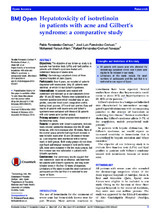Mostrar el registro sencillo del ítem
Hepatotoxicity of isotretinoin in patients with acne and Gilbert’s syndrome: a comparative study
| dc.contributor.author | Fernández-Crehuet, Pablo | |
| dc.contributor.author | Fernández-Crehuet, José Luis | |
| dc.contributor.author | Allam, Mohamed F. | |
| dc.contributor.author | Fernández-Crehuet Navajas, Rafael | |
| dc.date.accessioned | 2017-01-19T13:07:51Z | |
| dc.date.available | 2017-01-19T13:07:51Z | |
| dc.date.issued | 2014 | |
| dc.identifier.uri | http://hdl.handle.net/10396/14345 | |
| dc.description.abstract | Objectives: The objective of our follow-up study is to evaluate liver function tests (LFTs) and lipid profiles in patients with Gilbert’s syndrome treated with isotretinoin because of severe acne. Setting: Dermatology outpatient clinics of three regional hospitals of Jaén (Spain). Participants: Over 4 years, we included all patients diagnosed with severe acne. Only 37 patients were identified, of which 11 had Gilbert’s syndrome. Interventions: All patients were treated with isotretinoin and followed-up in our outpatient clinics after 10 and 20 weeks. Patients were subjected to an interview questionnaire which included data on age, gender, complete blood count, coagulation profile, fasting blood glucose, LFTs and lipid profiles. Data and results of patients with severe acne and Gilbert’s syndrome were compared with those of 26 patients with only severe acne (control group). Primary outcome: Blood analyses were repeated in the follow-up visits. Results: In patients with Gilbert’s syndrome, bilirubin levels showed substantial decrease over the 20-week follow-up, with more decrease after 10 weeks. None of the control group patients had significant increase in total bilirubin levels after 10 and 20 weeks of followup. Liver enzymes were maintained within normal levels in both groups. Both study groups did not show significant pathological increase in lipid profile levels. LDL levels were increased in the two study groups, but this increase was less substantial in patients with Gilbert’s syndrome. Conclusions: Our preliminary results suggest that oral isotretinoin could be an effective, safe treatment for patients with Gilbert’s syndrome, and may lower bilirubin levels in the first 10 weeks of treatment. Limitations of the study include the small numbers of participants and the fact that it is restricted to one region of Spain. | es_ES |
| dc.format.mimetype | application/pdf | es_ES |
| dc.language.iso | eng | es_ES |
| dc.publisher | BMJ | es_ES |
| dc.rights | https://creativecommons.org/licenses/by-nc-nd/4.0/ | es_ES |
| dc.source | BMJ Open 4:e004441 (2014) | es_ES |
| dc.subject | Clinical dermatology | es_ES |
| dc.subject | Acne | es_ES |
| dc.subject | Gilbert`s syndrome | es_ES |
| dc.title | Hepatotoxicity of isotretinoin in patients with acne and Gilbert’s syndrome: a comparative study | es_ES |
| dc.type | info:eu-repo/semantics/article | es_ES |
| dc.relation.publisherversion | http://dx.doi.org/10.1136/bmjopen-2013-004441 | es_ES |
| dc.rights.accessRights | info:eu-repo/semantics/openAccess | es_ES |

